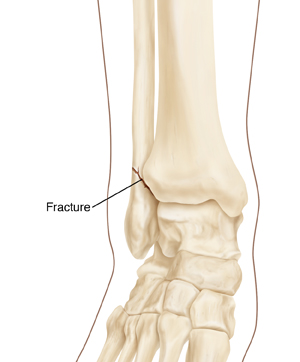Ankle Fracture, Distal Fibula
You have a fracture, or broken bone, of the end of the fibula bone. The fibula is 1 of 2 bones that support the ankle joint.

Home care
-
You will be given a splint, cast, or special boot to prevent movement at the injury site. Don't put weight on a splint. It will break. Follow your healthcare provider’s advice about when to begin bearing weight on a cast or boot.
-
Keep your leg raised when sitting or lying down. When sleeping, place a pillow under the injured leg. When sitting, support the injured leg so it's above heart level. This is very important during the first 48 hours.
-
Keep the cast or splint completely dry at all times. When bathing, protect the cast or splint with 2 large plastic bags. Place 1 bag outside of the other. Tape each bag with duct tape at the top end or use rubber bands. Water can still leak in even when the foot is covered. So it's best to keep the cast, splint, or boot away from water. If a fiberglass cast or splint gets wet, dry it with a hair dryer on a cool setting.
-
Place an ice pack over the injured area for no more than 15 to 20 minutes. Do this every 3 to 6 hours for the first 24 to 48 hours. Continue this 3 to 4 times a day as needed. To make an ice pack, put ice cubes in a plastic bag that seals at the top. Wrap the bag in a clean, thin towel or cloth. Never put ice or an ice pack directly on the skin. The ice pack can be put right on the cast or splint. As the ice melts, be careful that the cast or splint doesn’t get wet.
-
You may use over-the-counter pain medicine to control pain, unless another pain medicine was prescribed. If you have chronic liver or kidney disease or ever had a stomach ulcer, gastrointestinal bleeding, or take a blood thinner, talk with your provider before using these medicines.
Follow-up care
Follow up with your healthcare provider in 1 week, or as advised. This is to be sure the bone is healing properly. If you were given a splint, it may be changed to a cast or boot after the swelling goes down.
If X-rays were taken, you will be told of any new findings that may affect your care.
When to get medical advice
Call your healthcare provider right away if any of these occur:
-
The plaster cast or splint becomes wet or soft
-
The fiberglass cast or splint stays wet for more than 24 hours
-
There is increased tightness or pain under the cast or splint
-
Your toes become swollen, cold, blue, numb, or tingly
-
The cast or splint becomes loose
-
The cast or splint has a bad smell
-
Sore areas develop under the cast or splint
-
The cast or splint develops cracks or breaks
Online Medical Reviewer:
L Renee Watson MSN RN
Online Medical Reviewer:
Raymond Turley Jr PA-C
Online Medical Reviewer:
Thomas N Joseph MD
Date Last Reviewed:
1/1/2022
© 2000-2024 The StayWell Company, LLC. All rights reserved. This information is not intended as a substitute for professional medical care. Always follow your healthcare professional's instructions.